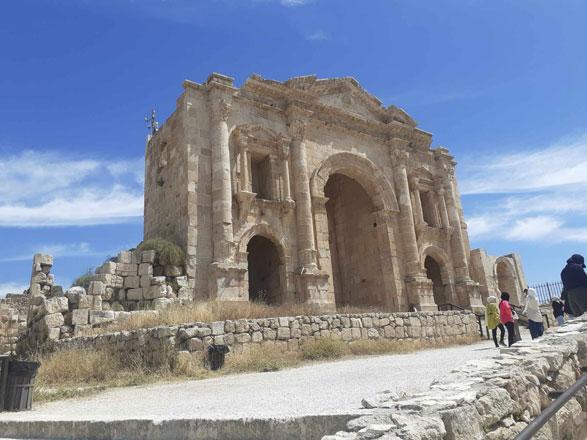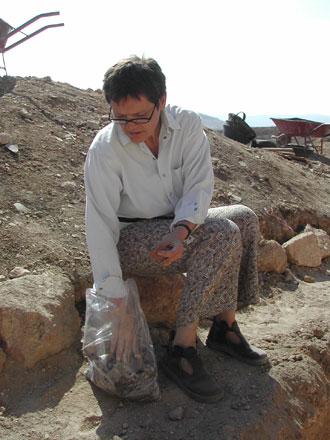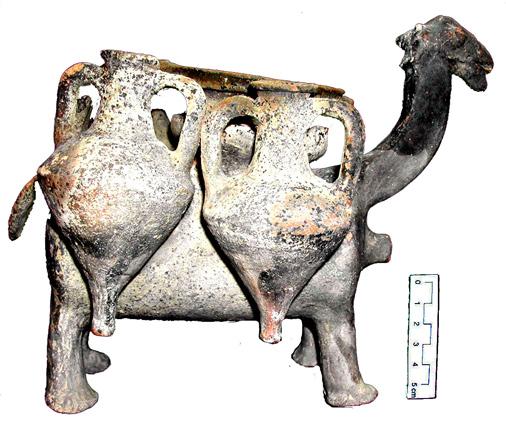You are here
Levantine pottery trade circulation: Hellenistic jugs discovery suggests ancient Jordanian-Cypriot trading links
By Saeb Rawashdeh - Nov 26,2023 - Last updated at Nov 27,2023

An oil terracotta flask from the Late Hellenistic Period [150BC-50BC] found on Cyprus (Photo courtesy of The Cesnola Collection)
AMMAN — The Hellenistic period stretching from 323BC to roughly 30BC, between the death of Alexander the Great and the rise of the Roman Empire, introduced religious, political and intellectual ideas that gradually shaped Levantine cities.
Recent archaeological discoveries of lagynoi, tall, narrow neck pitchers that were a status symbol during the Hellenistic period, have provided further evidence on how this period may have impacted Jordan.
Ina Kehrberg-Ostrasz from the University of Sydney described the lagynoi and explained how they may be connected to other lagynoi discoveries in the region, such as those found in Gerasa (modern day Jerash). Gerasa was one of the Hellenistic hubs and a centre for pottery production during the Hellenistic times.
“Excavators at the Amman Citadel found [at least] two lagynoi,” Kehrberg-Ostrasz said.
“The first jug can be compared with the local copy at Gerasa while the second, an import and described by the excavator as a ‘Hellenistic squat lekythos [probably from the 3rd century BC]’, is a lagynos type found at other sites outside Jordan.”
In addition to the lagynoi discovered in Amman and Gerasa, Kehrberg-Ostrasz noted the 1980s discovery of imported lagynoi in Pella (modern day Tabqet Fahel) that date back to the second to first centuries BC.
In Gerasa, the numerous painted, incised and composite pottery fragments from the Late Hellenistic and transitional Early Roman periods were identified by Kehrberg-Ostrasz as derivatives or local contemporary copies of imported lagynoi.
Kehrberg-Ostrasz described how the recently discovered lagynoi and those from Gerasa and Pella may be related to lagynoi from Cyprus, which was a hub for lagynoi production during the period.
“The discovery that Gerasene Hellenistic pottery includes locally manufactured lagynoi presents an opportunity to consider a Hellenistic Cypriot-Jordanian trading link,” the professor said, adding that the imported lagynoi may well be found to be of Cypriot production.
Kehrberg-Ostrasz highlighted the motifs, syntax, style and shape of the Gerasene lagynoi closely resemble those from Famagusta in Cyprus.
This similarity suggests that Cypriot lagynoi may have been the direct inspirational source for the Pella lagynoi, the Amman examples and other lagynoi found outside Jordan, Kehrberg-Ostrasz said.
“In order to obtain the same painterly ease, a potter would have to know the prototype[s] well so as to be able to render the same kind of vessel without necessarily having it in front of him,” she said.
Furthermore, the Gerasene sherds do not come from one potter but from several local workshops.
“This has led to the possibility that Cypriot products — and perhaps other imports too — were copied, although it appears reasonable to suggest that, with its proximity to and age-old links with Cyprus, northern Jordan was a main recipient of Cypriot products,” Kehrberg-Ostrasz noted.
Related Articles
AMMAN — In the 1st century BC and 1st century AD, Gerasa (modern Jerash) had operational quarries, which are types of open-pit mines used fo
AMMAN — Coming to Jordan for the first time in 1975-1978, Ina Kehrberg-Ostrasz joined the excavations at Teleilat Ghassul (five-six ki
AMMAN — Archaeologist Ina Kehrberg-Ostrasz has recently delved into the findings of an excavation of a small tomb containing the single buri

















